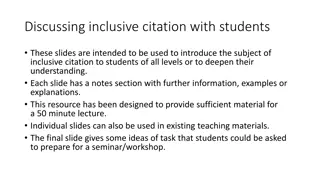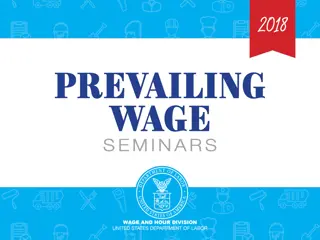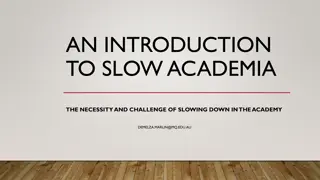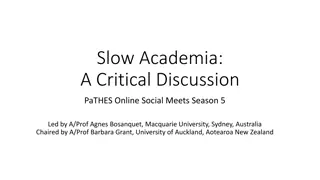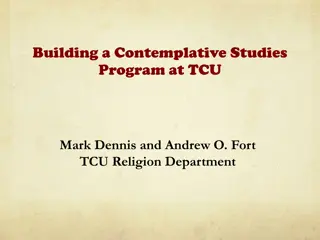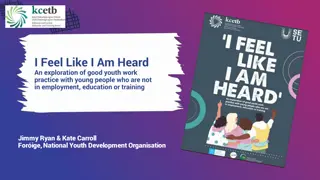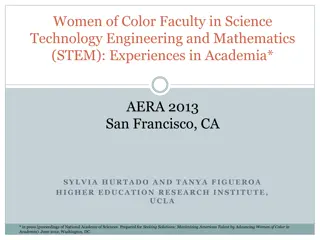Social Construction of NEETs in Academia: Insights and Perspectives
Miriam Avorin, a PhD student, is conducting research on how NEETs (young people not in employment, education, or training) are socially constructed and associated with social problems in academic literature. Over 150 peer-reviewed articles between 2008-2015 have been analyzed to understand the discourse surrounding NEETs, highlighting the challenges and limitations of using the NEET acronym to identify marginalized youth.
Download Presentation

Please find below an Image/Link to download the presentation.
The content on the website is provided AS IS for your information and personal use only. It may not be sold, licensed, or shared on other websites without obtaining consent from the author. Download presentation by click this link. If you encounter any issues during the download, it is possible that the publisher has removed the file from their server.
E N D
Presentation Transcript
What does Academia have to say about NEETs? Miriam Avorin, M.A. PhD-student
A doctoral compilation thesis Working title: Constructing a group politically and socially the case of Young people not in employment, education or training (NEETs). Focus: political and social construction (of NEETs) Compilation thesis four different articles/studies + several summarising chapters. Ongoing study (first article): how academics socially construct the NEET group in different peer review articles.
Material & Basic info Over 150 peer reviewed articles written on or about the acronym NEET(s), published between 2008 2015. NEET stands for Not in Education, Employment or Training (referring to a young age group). NEET was first coined in the UK, developed during the late 1980 s and firmly established as the only acceptable acronym to be used in the UK in 1999. By academia , I am specifically referring to the body of scientific community expressed through the medium of articles published in peer reviewed journals.
Main research question How is NEET socially constructed as a group and associated to social problems? Focus lies on how NEETs are defined, described and referenced to social problems in the selected material.
Theoretical framework Theoretical discussions on discourse and social constructionist perspectives. Theories focusing specifically on social problems in a social constructionist view
NEET a discussion on assumptions and use of the acronym According to Andy Furlong*, NEET is both too wide and too narrow to be used as an accurate tool for identifying marginalised young people in need of different benefit/social provisions. Assumption: we want to use NEET as a category to identify troubled youth . With that purpose, the NEET acronym is not entirely adequate Main focus is thus: purpose, assumptions and associating a group to certain ideas/notions/preconceptions *Furlong, A. 2006. Not a Very NEET Solution: Representing Problematic Labour Market Transitions among Early School-Leavers. Work, Employment & Society 20(3): 553 569.
Data selection process Using two different databases: Scopus and Web of Science. Delimitations in time frame: January 2008- April 2016 Delimitations: Main focus in the article must be NEET Additional searches completes the material from a multidatabase platform and reference searches (First search resulted in 16 000+ entries. This was narrowed down considerably with proper delimitations)
Methods This study opts for both doing discourse analysis and hybrid qualitative content analysis with focus on Keyword-in-context- analysis (KWIC) as well a category-labelling. The discourse analysis rests on three different themes with sub- questions in order to analyse patterns of association. The KWIC consists of keywords from abstracts and provide a list with category labelled words, as well as a chain-of-equivalence analysis.
Examples of category-labelled keywords CRIME/DRUGS/ADDICTION addiction drugs alcohol Cannabis use Cigarette smoking Crime trends anti-social behaviour registered crime substance-related disorders unlawful behaviours/Juvenile crimes juvenile delinquents Crime deviant behaviours gravity scores young offenders peer aggression *INCLUDE/EXCLUDE/PARTICIPATE* Social exclusion Exclusion polarisation Marginalisation/marginalization Stigmatisation Disengagement participation social inclusion non-participation *INDIVIDUAL/SELF/IDENTITY* identity individualisation self-confidence self-esteem self-perceptions individual strategies general self-efficacy Self-confidance self-efficacy self-esteem
Chain-of-equivalence analysis - Keywords Figure 2. CHAIN OF EQUIVALENCE ANALYSIS CATEGORISING DESCRIPTIVE KEYWORDS ON NEET EXAMPLE OF KEYWORDS CODE Crime, Deviant behaviours, Anti-social behaviour, Drugs, Alcohol, Substance abuse, etc. CRIMINAL/ /ADDICT Disadvantaged youth, Marginalisation, Vulnerability, etc. VICTIM/MARGIN Health, Isolation, Depression, Anxiety, Obesity, Food choices, etc. SICK/HEALTH Disengaged, Youth inactiveness, Underachievers, Participation, etc. PASSIVE/ACTIVE
Discourse analysis on focus material Randomized sampling to narrow down into a smaller focus material. The 151 articles are all relevant (narrowed down from a entry list of 16 000+ articles). Therefore, I am using a simple randomized selection using the lottery method. The in-depth reading of the focus material will follow a guide consisting of themes and sub-questions connected to my research question.
Themes and sub-questions 1) Claims made of specified problems linked to NEETs = PROBLEM CLAIMS Which problems are specified? Problem for whom exactly? Is it a problem for society or a problem for the individual NEET, or both? How the problem is described, how are NEETs (or society) claimed to be experiencing these problems? Where in the article are problems referred to? Does the description or mention of problems come in the introductory part of the article or is it presented in the end as a form of finding/empirical result? Or throughout the entire article? This question is important as it may also show whether or not problems are accounted for as a given parameter or as a result from the inquiry in question. 2) Descriptions of NEET = DESCRIPTION How are NEET described? With what words? 3) Stated purpose of the articles = PURPOSE Why is it important to conduct this specific type of research? What motivates the study? And why care about NEETs?
Findings thus far (very preliminary) NEETs are strongly associated to various social problems and health issues, as both the keyword analysis as well as the discourse analysis serve to show. Many of these associations are evident already in the introduction of the articles, and presented in a taken-for- granted factual way. Critical, reflexive standpoints on the acronym NEET is relatively rare.
Conference bonus NEET is of global concern, Europe is dominating the research (with the UK at top), accompanied by many countries in Asia (predominantly Japan), Australia and New Zealand, USA and Mexico. Also, academia is showing a growing interest in NEET, as publications increase steadily over time. The most popular disciplines are Social Sciences, with Education and Youth Studies as primary subjects. (NEET is also of substantial interest in disciplines such as Medicine and Health, Psychology, Sociology, Economics as well as Arts and Humanities)
Conference bonus The articles can be sorted roughly into the following types: Evaluating (on programs, methods, policies) Ethnographic Macro-analytical (social policy, social politics) Statistical demographic- longitudinal Medical/health oriented Education, profession, career-oriented
Thank you! miriam.avorin@liu.se www.isv.liu.se/medarbetare-vid-isv/avorin-miriam/presentation www.liu.se















